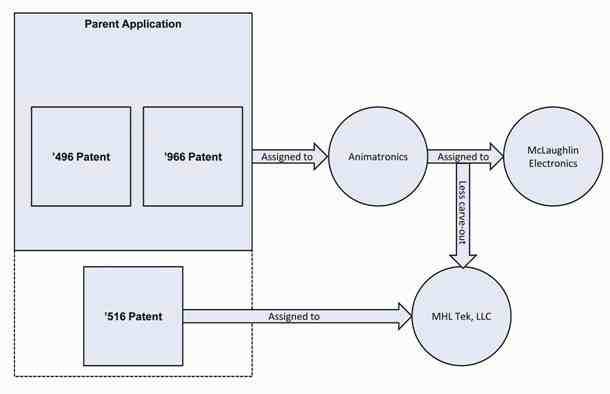A recent decision of the Federal Circuit highlights the importance of the language of patent assignments. In MHL Tek, LLC v. Nissan Motor Co.,[1]the court dismissed all claims of patent infringement by MHL Tek, LLC (“MHL”) by finding that MHL lacked standing as a result of the rights transferred in a series of patent assignments. This result highlights the importance of drafting clear patent assignments that transfer those rights, and only those rights, that are intended. Any ambiguity may result in unintended consequences for either the transferor or transferee, or both.
MHL asserted patents that included technology related to tire pressure monitoring systems against a variety of automobile manufacturers. The asserted patents included U.S. Patent Nos. 5,663,496 (the “’496 patent”), 5,741,966 (the “’966 patent”), and 5,731,516 (the “’516 patent”). The ’496 patent and the ’966 patent are both divisionals of a common parent application (the “Parent Application”). The ’516 patent, however, is not related to this family of patents.
A complicated trail of assignments then occurred that ultimately led to the Appeal after the District Court for the Eastern District of Texas dismissed the suit because MHL lacked standing to assert the ’496 patent and the ’966 patent and granted summary judgment of noninfringement of the ’516 patent. The chart below depicts the assignments that ensued after the patents at issue in this suit were filed.
First, the inventors of the ’496 patent and the ’966 patent executed an assignment in which “[the inventors] do hereby assign, sell, and set over to ANIMATRONICS, INC . . . the entire right, title and interest, domestic and foreign, in and to the inventions and discoveries in [the Parent Application].” Animatronics, Inc. (“Animatronics”) subsequently executed an assignment to McLaughlin Electronics of the “entire right, title and interest, domestic and foreign, in and to the inventions and discoveries set forth in the [Parent] Application,” but the assignment also stated that the assignment “shall not cover any rights to the [Parent] Application that concern the Animatronics Proprietary Inventions” (the “carve-out provision”).

Second, the inventors signed documents that purported to assign the patents-in-suit to MHL. In addition, Animatronics assigned its interests, if any, in the patents-in-suit to MHL. MHL’s claims of infringement were then based on its ownership of the patents-in-suit either from direct assignment by the inventors or from the transfer of Animatronics’ rights that Animatronics had retained as a result of the carve-out provision.
The Federal Circuit ultimately held that MHL lacked standing to assert its claim of infringement with respect to any of the three asserted patents. The language of the patent assignments and the subject matter that was related to the language of the patents were the determining factors in the court’s decision.
First, MHL argued that it owned rights in the ’496 patent and the ’966 patent as a result of the transfer of rights in these patents from Animatronics to MHL because the claims asserted in the suit fell into the carve-out provision. The Federal Circuit disagreed. The court looked at the carve-out provision of the assignment documents and determined that the asserted claims were not covered by the carve-out provision. The court then stated that MHL lacked standing to assert the two patents.
Second, MHL sought to assert the ’516 patent because, MHL argued, the ’516 patent was not assigned with the other two asserted patents. Here, the court looked to the language of the initial assignment from the inventors to Animatronics. The assignment transferred all rights and interest “in and to the inventions and discoveries set forth in the [Parent] Application.” MHL argued that the ’516 patent was not transferred because it is not related to the Parent Application. The Federal Circuit disagreed. The court stated that if the claims of the ’516 patent were supported by the specification of the Parent Application, then the patent assignment transferred those rights to Animatronics and then subsequently to McLaughlin Electronics. After a review of the specification, the court found that the specification did indeed support the claims of the ’516 patent, and the rights were therefore transferred.
With no valid interest in the asserted patents, MHL’s claims of patent infringement were dismissed. This result highlights the importance of drafting clear patent assignments that transfer those rights, and only those rights, that are intended. Any ambiguity may result in unintended consequences for either the transferor or transferee, or both.
Practice Tips:
- Always carefully draft and review technology transfers to determine the boundaries of the rights transferred
- When purchasing rights in technology, always review prior transfers to ensure you are receiving the rights and value that you believe you are receiving
- When a transfer of less than all the rights in a patent is made, carefully determine and define those rig
[1] No. 2010-1287, -1317, -1318 (Fed. Cir. Aug. 10, 2011), available at http://www.cafc.uscourts.gov/images/stories/opinions-orders/10-1287 -1317 -1318.pdf (last accessed 8 November 2011).


 />i
/>i


